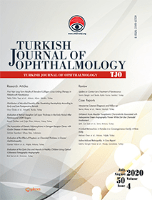
Turk Oftalmoloji Dergisi-Turkish Journal of Ophthalmology
Scope & Guideline
Championing Quality Research in Eye Care
Introduction
Aims and Scopes
- Clinical Ophthalmology:
The journal emphasizes clinical studies that assess the effectiveness of various treatment modalities and surgical interventions in ophthalmology. Research often includes comparisons of surgical techniques and outcomes, patient demographics, and specific disease management strategies. - Innovative Diagnostic Techniques:
There is a strong focus on the development and application of advanced imaging and diagnostic technologies, such as Optical Coherence Tomography (OCT) and multimodal imaging, to enhance the understanding of ocular diseases and improve diagnostic accuracy. - Pathophysiology of Ocular Diseases:
Research articles frequently explore the underlying mechanisms of various ocular conditions, including age-related macular degeneration, glaucoma, and diabetic retinopathy, contributing to a deeper understanding of these diseases. - Pediatric Ophthalmology:
The journal includes a significant amount of research dedicated to pediatric eye conditions, addressing unique challenges and treatment approaches in children, such as retinopathy of prematurity and congenital cataracts. - Public Health and Epidemiology:
The journal also addresses public health issues related to ocular diseases, including studies on the prevalence of eye diseases in specific populations and the impact of systemic conditions on ocular health. - Psychosocial Aspects of Eye Disease:
The exploration of the psychological and social implications of ocular diseases is a notable aspect, with studies assessing quality of life and emotional well-being of patients with chronic eye conditions.
Trending and Emerging
- Telemedicine and Remote Monitoring:
There is a growing trend towards research on telemedicine applications in ophthalmology, especially in the context of the COVID-19 pandemic. This includes studies on remote monitoring of patients and the effectiveness of virtual consultations. - Integration of Artificial Intelligence (AI):
The use of artificial intelligence and machine learning techniques in diagnosing and managing eye diseases is increasingly prevalent. Recent studies are exploring AI's role in enhancing diagnostic accuracy and treatment outcomes. - Ocular Implications of Systemic Diseases:
Emerging research is focusing on the interplay between systemic diseases (such as diabetes and COVID-19) and ocular health, highlighting how systemic conditions can influence ocular diseases and vice versa. - Psychosocial Impact of Ocular Conditions:
There is an increasing emphasis on understanding the psychosocial effects of eye diseases on patients, including studies on mental health outcomes and quality of life assessments. - Regenerative Medicine and Tissue Engineering:
Innovative approaches such as tissue engineering and regenerative medicine are gaining traction, with research exploring their potential applications in ophthalmology, particularly for conditions like corneal defects and retinal diseases.
Declining or Waning
- Basic Science and Laboratory Studies:
There seems to be a decline in the number of basic science studies focusing on laboratory research regarding ocular biology and pathology. The shift towards clinical and translational research may indicate a waning interest in purely laboratory-based investigations. - Traditional Surgical Techniques:
Research focusing on older surgical methods and techniques appears to be decreasing, as the journal increasingly highlights advanced and minimally invasive surgical approaches, reflecting a broader trend towards innovation in surgical practices. - Ocular Pharmacology:
The exploration of pharmacological treatments for ocular diseases has seen a decline. While there are still relevant studies, the emphasis may be shifting towards surgical and non-pharmacological interventions.
Similar Journals

Eye and Vision
Advancing the frontiers of ophthalmology and visual sciences.Eye and Vision, published by BMC, is a leading open-access journal dedicated to the dynamic field of ophthalmology and visual sciences. With its ISSN 2326-0246 and E-ISSN 2326-0254, the journal has established itself as a premier platform for innovative research and clinical studies, achieving impressive rankings in 2023 as Q1 in both Health Professions (Miscellaneous) and Ophthalmology categories. The journal's commitment to accessible knowledge since its transition to open access in 2015 enhances its global reach, allowing researchers, clinicians, and students to share and access top-tier studies and advancements in the field. Located in the United Kingdom and delivering influential insights from 2014 through to 2024, Eye and Vision holds significant relevance, with a Scopus ranking placing it in the 99th percentile for Health Professions and the 93rd percentile for Ophthalmology, making it an essential resource for those looking to stay at the forefront of eye research and vision science.
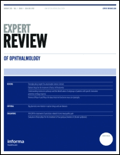
Expert Review of Ophthalmology
Advancing Vision Science through Expert InsightsExpert Review of Ophthalmology is a leading academic journal published by ROUTLEDGE JOURNALS, TAYLOR & FRANCIS LTD, specializing in the rapidly evolving field of ophthalmology. With its ISSN 1746-9899 and E-ISSN 1746-9902, this journal has been at the forefront of disseminating critical research and insightful reviews since its inception in 2006. Covering a broad spectrum of topics within ophthalmology, it plays a pivotal role in advancing knowledge and practice, especially given its prestigious standings in various quartile rankings, including Q1 in Public Health and Q2 in Immunology and Allergy for 2023. The journal aims to provide professionals, researchers, and students with comprehensive perspectives on contemporary challenges and innovations in ophthalmology. Generously supported by a robust peer-review process, the journal ensures that all published works meet high academic standards, thereby serving as a vital resource for anyone looking to stay informed about the latest developments in eye care and vision science. By bridging research and clinical application, Expert Review of Ophthalmology is essential for those aiming to contribute meaningfully to this critical field.
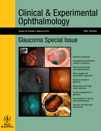
CLINICAL AND EXPERIMENTAL OPHTHALMOLOGY
Elevating Standards in Clinical Ophthalmic ResearchCLINICAL AND EXPERIMENTAL OPHTHALMOLOGY is a leading peer-reviewed journal published by Wiley, renowned for its commitment to advancing the field of ophthalmology. With an impressive impact factor reflecting its high-quality research contributions, this journal is ranked in the Q1 category both in Medicine (miscellaneous) and Ophthalmology, signifying its crucial role in shaping contemporary ophthalmic research. It boasts a remarkable position in the Scopus Ranks, standing at Rank #13 out of 137 in the field of Medicine and Ophthalmology, placing it within the 90th percentile among its peers. Having been in circulation since 1979, this journal encompasses a broad scope of topics that aim to disseminate groundbreaking findings and stimulate dialogue among researchers, clinicians, and students alike. It is easily accessible to a global audience, embodying the principles of open access, making valuable research available to all. For anyone seeking to stay at the forefront of ophthalmology, CLINICAL AND EXPERIMENTAL OPHTHALMOLOGY is an indispensable resource that fosters knowledge and innovation in the ever-evolving landscape of eye care.

Ophthalmology Science
Shaping the Future of OphthalmologyOphthalmology Science is a premier journal published by Elsevier, dedicated to advancing the field of ophthalmology through innovative research and clinical insights. With an impact factor that positions it in the Q1 category of ophthalmology journals, it stands out as a crucial resource for researchers, clinicians, and students alike. The journal, indexed under ISSN 2666-9145, covers a wide array of topics relevant to eye care, encompassing the latest breakthroughs in diagnostics, therapeutics, and surgical techniques. Operating in the United States from its office in Amsterdam, the journal aims to bridge the gap between laboratory findings and clinical applications, contributing to improved patient outcomes globally. The converged years from 2021 to 2024 reflect its commitment to providing timely and impactful research that shapes the future of ophthalmic practice. Make sure to explore the open access options available for wider dissemination of your work and to stay ahead in the evolving landscape of ophthalmology.
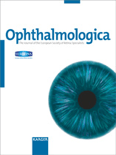
OPHTHALMOLOGICA
Connecting Disciplines to Enhance Vision CareOPHTHALMOLOGICA is a prestigious journal published by KARGER, dedicated to the dynamic field of ophthalmology and its interdisciplinary connections with medicine and sensory systems. With a rich history spanning over a century since its inception in 1899, this journal is esteemed for its high-quality research and impactful contributions, maintaining an impressive Q1 quartile ranking in both ophthalmology and miscellaneous medicine as of 2023, alongside a notable Q2 status in sensory systems. The journal's influence is reinforced by its Scopus rankings, where it ranks 26th out of 137 in ophthalmology, showcasing a strong percentile position of 81. Based in Basel, Switzerland, OPHTHALMOLOGICA serves as an essential platform for researchers, professionals, and students, providing essential insights, reviews, and studies that push the boundaries of knowledge in the vision sciences. Although it does not currently offer open access, its contributions are critical for those pursuing advancements in ocular health and related disciplines.

Nepalese Journal of Ophthalmology
Connecting Knowledge and Practice in Eye CareNepalese Journal of Ophthalmology, established by the NEPAL OPHTHALMIC SOC, is a premier Open Access journal dedicated to advancing the field of ophthalmology. With its ISSN 2072-6805 and E-ISSN 2091-0320, the journal provides an important platform for sharing innovative research and clinical findings in eye health. Since its inception in 2009, the journal has aimed to disseminate high-quality research that addresses contemporary challenges in ophthalmic practices, thus supporting improved patient care and outcomes within Nepal and beyond. The journal has achieved notable recognition, evidenced by its Scopus rank of #267 out of 915 in the field of General Medicine, placing it within the 70th percentile. Researchers, professionals, and students will find valuable information in its comprehensive articles, which cater to a multidisciplinary audience interested in the latest developments in ophthalmology. Emphasizing accessibility, the journal ensures that all published content is freely available, fostering collaboration and knowledge sharing in the global medical community.
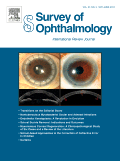
SURVEY OF OPHTHALMOLOGY
Leading the Conversation in Ophthalmic ExcellenceSURVEY OF OPHTHALMOLOGY is a premier journal published by Elsevier Science Inc, dedicated to advancing knowledge in the field of ophthalmology. With an impact factor reflective of its high-quality research—ranking 7th out of 137 in the Scopus category for medicine and ophthalmology, this journal maintains a prestigious Q1 categorization in its field for 2023. Since its inception in 1956, the journal has provided comprehensive reviews and original articles covering various aspects of ophthalmic research and clinical practice, supporting the ongoing education of researchers, professionals, and students alike. While open access options are not available, the journal remains an essential resource for the latest developments, discoveries, and expert insights that shape the future of eye health. Based in the United States, at STE 800, 230 Park Ave, New York, NY 10169, the journal continues a legacy of excellence in ophthalmology until 2024 and beyond, making it a pivotal element of scholarly discourse in this vital medical discipline.
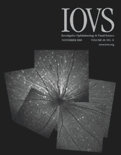
INVESTIGATIVE OPHTHALMOLOGY & VISUAL SCIENCE
Unveiling discoveries in ophthalmology.Investigative Ophthalmology & Visual Science (IOVS) is a leading academic journal published by the Association for Research in Vision and Ophthalmology, dedicated to advancing the field of ophthalmology and visual science. With an impressive impact factor and ranking in the Q1 category for both Ophthalmology and Sensory Systems, IOVS is well-respected for disseminating cutting-edge research and innovative discoveries. Established in 1977, this Open Access journal allows for broad accessibility to pioneering studies, fostering collaboration among researchers, clinicians, and students. The journal has consistently maintained high visibility in the academic community, evidenced by its robust rankings in Scopus, including Rank #16 in Ophthalmology. As it continues to pave the way for future developments in the understanding and treatment of ocular diseases, IOVS serves as an invaluable resource for those immersed in the complex field of visual science.
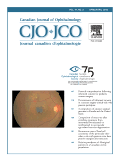
CANADIAN JOURNAL OF OPHTHALMOLOGY-JOURNAL CANADIEN D OPHTALMOLOGIE
Shaping the landscape of ophthalmology since 1966.Canadian Journal of Ophthalmology - Journal Canadien d'Ophtalmologie, published by the prestigious Canadian Ophthalmological Society, serves as a leading platform for disseminating cutting-edge research in the field of ophthalmology. With an ISSN of 0008-4182 and E-ISSN 1715-3360, the journal boasts a commendable impact factor and maintains a strong presence within the medicine and ophthalmology categories, ranking in the Q2 quartile. This journal not only provides significant insights into clinical practices and advancements but also contributes to the understanding of ocular health issues facing contemporary society. Since its inception in 1966, it has published high-quality research, making substantial strides in both practical and theoretical aspects of ophthalmology until 2024. Although it is not an open-access journal, it establishes a vital resource for researchers, professionals, and students alike, fostering an informed community dedicated to improving vision care.

International Journal of Retina and Vitreous
Fostering global collaboration for eye health advancements.The International Journal of Retina and Vitreous, published by BMC, stands as a premier open-access platform dedicated to advancing the field of ophthalmology, specifically focusing on retina and vitreous research. Established in 2015, this journal has swiftly positioned itself within the academic community, achieving a commendable Q2 category ranking in Ophthalmology for 2023, and ranks #49 out of 137 in Scopus for Medicine - Ophthalmology, indicating its growing influence and reach within the scientific landscape. The journal is committed to disseminating high-quality research, reviews, and clinical insights that explore innovations, challenges, and breakthroughs in ocular health. With the goal of fostering knowledge exchange among researchers, practitioners, and students, the International Journal of Retina and Vitreous promotes an open-access model, ensuring that vital findings are readily available to a global audience. This journal not only serves as a vital resource for advancing the understanding and treatment of retinal and vitreous diseases but also aims to inspire future studies in this critical area of eye health.